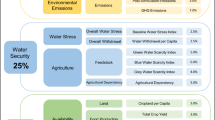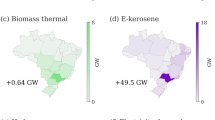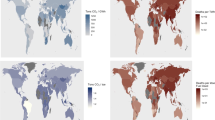Abstract
With limited decarbonization options in the aviation sector, renewable jet fuels produced from biomass resources represent a promising opportunity. However, potential implications of their deployment on the Sustainable Development Goals (SDGs) remain largely unexplored. We introduce an approach for SDG analysis based on life-cycle impact assessment methods. We show that climate action benefits of renewable jet fuels produced from forest residues available in Norway are larger in the medium/longer term than the shorter term, but they increase pressure on other SDGs—mainly SDGs 2, 3, 6, 11, 12 and 14—especially for alcohol-to-jet fuel technology. Most of these adverse side-effects are alleviated with technological and supply-chain improvements. Environmental sustainability analysis can identify both synergies (mitigation options that co-deliver across SDGs) and trade-offs between climate change mitigation and the SDGs, thereby supporting their early management and mitigation.
This is a preview of subscription content, access via your institution
Access options
Access Nature and 54 other Nature Portfolio journals
Get Nature+, our best-value online-access subscription
$29.99 / 30 days
cancel any time
Subscribe to this journal
Receive 12 digital issues and online access to articles
$119.00 per year
only $9.92 per issue
Buy this article
- Purchase on Springer Link
- Instant access to full article PDF
Prices may be subject to local taxes which are calculated during checkout




Similar content being viewed by others
Data availability
The main data that support the findings of this study are available in the Supplementary Information. Other information is available from the corresponding author upon request.
References
Alexander, P. et al. Assessing uncertainties in land cover projections. Glob. Change Biol. 23, 767–781 (2017).
Popp, A. et al. Land-use futures in the shared socio-economic pathways. Glob. Environ. Change 42, 331–345 (2017).
Technology Roadmap: Delivering Sustainable Bioenergy (IEA, 2017).
Moore, R. H. et al. Biofuel blending reduces particle emissions from aircraft engines at cruise conditions. Nature 543, 411–415 (2017).
The Norwegian National Transport Plan 2018–2029: A Targeted and Historic Commitment to the Norwegian Transport Sector (Norwegian Ministry of Transport and Communications, 2017); https://www.regjeringen.no/contentassets/7c52fd2938ca42209e4286fe86bb28bd/en-gb/pdfs/stm201620170033000engpdfs.pdf
Stratton, R. W., Wolfe, P. J. & Hileman, J. I. Impact of aviation non-CO2 combustion effects on the environmental feasibility of alternative jet fuels. Environ. Sci. Technol. 45, 10736–10743 (2011).
Staples, M. D., Malina, R., Suresh, P., Hileman, J. I. & Barrett, S. R. Aviation CO2 emissions reductions from the use of alternative jet fuels. Energy Policy 114, 342–354 (2018).
Han, J., Elgowainy, A., Cai, H. & Wang, M. Q. Life-cycle analysis of bio-based aviation fuels. Bioresour. Technol. 150, 447–456 (2013).
De Jong, S. et al. Life-cycle analysis of greenhouse gas emissions from renewable jet fuel production. Biotechnol. Biofuels 10, 64 (2017).
Staples, M. D. et al. Lifecycle greenhouse gas footprint and minimum selling price of renewable diesel and jet fuel from fermentation and advanced fermentation production technologies. Energy Environ. Sci. 7, 1545–1554 (2014).
Klein, B. C. et al. Techno-economic and environmental assessment of renewable jet fuel production in integrated Brazilian sugarcane biorefineries. Appl. Energy 209, 290–305 (2018).
Connelly, E. B., Colosi, L. M., Clarens, A. F. & Lambert, J. H. Life cycle assessment of biofuels from algae hydrothermal liquefaction: the upstream and downstream factors affecting regulatory compliance. Energy Fuels 29, 1653–1661 (2015).
Levasseur, A. et al. Enhancing life cycle impact assessment from climate science: review of recent findings and recommendations for application to LCA. Ecol. Indic. 71, 163–174 (2016).
Fuglestvedt, J. S. et al. Transport impacts on atmosphere and climate: metrics. Atmos. Environ. 44, 4648–4677 (2010).
Stevenson, D. S. & Derwent, R. G. Does the location of aircraft nitrogen oxide emissions affect their climate impact?. Geophys. Res. Lett. 36, L17810 (2009).
Lund, M. T. et al. Emission metrics for quantifying regional climate impacts of aviation. Earth Syst. Dynam. 8, 547–563 (2017).
Lee, D. et al. Transport impacts on atmosphere and climate: aviation. Atmos. Environ. 44, 4678–4734 (2010).
Köhler, M. O., Rädel, G., Shine, K., Rogers, H. & Pyle, J. A. Latitudinal variation of the effect of aviation NOx emissions on atmospheric ozone and methane and related climate metrics. Atmos. Environ. 64, 1–9 (2013).
Work of the Statistical Commission Pertaining to the 2030 Agenda for Sustainable Development: Resolution Adopted by the General Assembly on 6 July 2017 (United Nations, 2017).
Liu, J. et al. Systems integration for global sustainability. Science 347, 1258832 (2015).
Pradhan, P., Costa, L., Rybski, D., Lucht, W. & Kropp, J. P. A systematic study of Sustainable Development Goal (SDG) interactions. Earth’s Future 5, 1169–1179 (2017).
Nerini, F. F. et al. Mapping synergies and trade-offs between energy and the Sustainable Development Goals. Nat. Energy 3, 10–15 (2018).
Nilsson, M., Griggs, D. & Visbeck, M. Map the interactions between Sustainable Development Goals. Nature 534, 320–322 (2016).
Bonsch, M. et al. Trade‐offs between land and water requirements for large‐scale bioenergy production. GCB Bioenergy 8, 11–24 (2016).
Humpenöder, F. et al. Large-scale bioenergy production: how to resolve sustainability trade-offs? Environ. Res. Lett. 13, 024011 (2018).
Von Stechow, C. et al. 2 °C and SDGs: united they stand, divided they fall?. Environ. Res. Lett. 11, 034022 (2016).
Lu, Y., Nakicenovic, N., Visbeck, M. & Stevance, A.-S. Five priorities for the UN Sustainable Development Goals. Nature 520, 432–433 (2015).
Chandrakumar, C. & McLaren, S. J. Towards a comprehensive absolute sustainability assessment method for effective Earth system governance: defining key environmental indicators using an enhanced-DPSIR framework. Ecol. Indic. 90, 577–583 (2018).
Wulf, C. et al. Sustainable Development Goals as a guideline for indicator selection in life cycle sustainability assessment. Procedia CIRP 69, 59–65 (2018).
Dong, Y. & Hauschild, M. Z. Indicators for environmental sustainability. Procedia CIRP 61, 697–702 (2017).
Maier, S. D. et al. Methodological approach for the sustainability assessment of development cooperation projects for built innovations based on the SDGs and life cycle thinking. Sustainability 8, 1006 (2016).
Hellweg, S. & i Canals, L. M. Emerging approaches, challenges and opportunities in life cycle assessment. Science 344, 1109–1113 (2014).
De Jong, J., Akselsson, C., Egnell, G., Löfgren, S. & Olsson, B. A. Realizing the energy potential of forest biomass in Sweden—how much is environmentally sustainable? Forest Ecol. Manage. 383, 3–16 (2017).
Lundmark, T. et al. Potential roles of Swedish forestry in the context of climate change mitigation. Forests 5, 557–578 (2014).
Mawhood, R., Gazis, E., de Jong, S., Hoefnagels, R. & Slade, R. Production pathways for renewable jet fuel: a review of commercialization status and future prospects. Biofuels Bioprod. Biorefin. 10, 462–484 (2016).
Sales of Petroleum Products Statistics Norway (2017); https://www.ssb.no/en/statbank/table/11185
Repo, A., Tuomi, M. & Liski, J. Indirect carbon dioxide emissions from producing bioenergy from forest harvest residues. GCB Bioenergy 3, 107–115 (2011).
Guest, G., Cherubini, F. & Strømman, A. H. The role of forest residues in the accounting for the global warming potential of bioenergy. GCB Bioenergy 5, 459–466 (2013).
Cherubini, F. et al. Global spatially explicit CO2 emission metrics for forest bioenergy. Sci. Rep. 6, 20186 (2016).
Collier, Z. A., Connelly, E. B., Polmateer, T. L. & Lambert, J. H. Value chain for next-generation biofuels: resilience and sustainability of the product life cycle. Environ. Syst. Decis. 37, 22–33 (2017).
Connelly, E. B., Colosi, L. M., Clarens, A. F. & Lambert, J. H. Risk analysis of biofuels industry for aviation with scenario‐based expert elicitation. Syst. Eng. 18, 178–191 (2015).
Commercial Roundwood Removals Statistics Norway (2017); https://www.ssb.no/en/statbank/table/03795
Bright, R. M. & Strømman, A. H. Life cycle assessment of second generation bioethanols produced from Scandinavian boreal forest resources. J. Ind. Ecol. 13, 514–531 (2009).
Guest, G. & Strømman, A. H. Climate change impacts due to biogenic carbon: addressing the issue of attribution using two metrics with very different outcomes. J. Sustain. Forest. 33, 298–326 (2014).
Arvesen, A. et al. Cooling aerosols and changes in albedo counteract warming from CO2 and black carbon from forest bioenergy in Norway. Sci. Rep. 8, 3299 (2018).
Oreggioni, G. D. et al. Environmental assessment of biomass gasification combined heat and power plants with absorptive and adsorptive carbon capture units in Norway. Int. J. Greenh. Gas Con. 57, 162–172 (2017).
Wernet, G. et al. The ecoinvent database version 3 (part I): overview and methodology. Int. J. Life Cycle Assess. 21, 1218–1230 (2016).
Tuomi, M., Rasinmäki, J., Repo, A., Vanhala, P. & Liski, J. Soil carbon model Yasso07 graphical user interface. Environ. Model. Softw. 26, 1358–1362 (2011).
Hijmans, R. J., Cameron, S. E., Parra, J. L., Jones, P. G. & Jarvis, A. Very high resolution interpolated climate surfaces for global land areas. Int. J. Climatol. 25, 1965–1978 (2005).
Cherubini, F. et al. Bridging the gap between impact assessment methods and climate science. Environ. Sci. Policy 64, 129–140 (2016).
Humbird, D. et al. Process Design and Economics for Biochemical Conversion of Lignocellulosic Biomass to Ethanol: Dilute-Acid Pretreatment and Enzymatic Hydrolysis of Corn Stover (National Renewable Energy Laboratory, 2011).
Narula, C. K., Davison, B. H. & Keller, M. Zeolitic catalytic conversion of alochols to hydrocarbons. US Patent 9,533,921 (2017).
Molino, A., Chianese, S. & Musmarra, D. Biomass gasification technology: the state of the art overview. J. Energy Chem. 25, 10–25 (2016).
Simell, P. et al. Clean syngas from biomass—process development and concept assessment. Biomass Convers. Biorefin. 4, 357–370 (2014).
Hannula, I. & Kurkela, E. Liquid Transportation Fuels via Large-Scale Fluidised-Bed Gasification of Lignocellulosic Biomass (VTT, 2013).
Jungbluth, N. et al. Life Cycle Inventories of Bioenergy: Data v2.0 Report 17 (ecoinvent, 2007).
Dones, R. et al. Sachbilanzen von Energiesystemen: Grundlagen für den Ökologischen Vergleich von Energiesystemen und den Einbezug von Energiesystemen in Ökobilanzen für die Schweiz Final Report 6 (ecoinvent, 2000).
Spielmann, M., Bauer, C., Dones, R. & Tuchschmid, M. Transport Services Report 14 (ecoinvent, 2007).
Bond, T. C. et al. A technology‐based global inventory of black and organic carbon emissions from combustion. J. Geophys. Res. Atmos. 109, D14203 (2004).
Caiazzo, F., Agarwal, A., Speth, R. L. & Barrett, S. R. Impact of biofuels on contrail warming. Environ. Res. Lett. 12, 114013 (2017).
Levasseur, A. et al. in Global Guidance for Life Cycle Assessment Indicators (eds Frischknecht, R. & Jolliet, O.) 58–75 (2017).
Myhre, G. et al. in Climate Change 2013: The Physical Science Basis (eds. Stocker, T. F. et al.) 659–740 (Cambridge Univ. Press, 2013).
Shine, K. P., Fuglestvedt, J. S., Hailemariam, K. & Stuber, N. Alternatives to the global warming potential for comparing climate impacts of emissions of greenhouse gases. Clim. Change 68, 281–302 (2005).
Shine, K. P. The global warming potential—the need for an interdisciplinary retrial. Clim. Change 96, 467–472 (2009).
Allen, M. R. et al. New use of global warming potentials to compare cumulative and short-lived climate pollutants. Nat. Clim. Change 6, 773–776 (2016).
Søvde, O. A. et al. The chemical transport model Oslo CTM3. Geosci. Model Dev. 5, 1441–1469 (2012).
Bock, L. & Burkhardt, U. Reassessing properties and radiative forcing of contrail cirrus using a climate model. J. Geophys. Res. Atmos. 121, 9717–9736 (2016).
Bock, L. & Burkhardt, U. The temporal evolution of a long‐lived contrail cirrus cluster: simulations with a global climate model. J. Geophys. Res. Atmos. 121, 3548–3565 (2016).
Carslaw, K. et al. Large contribution of natural aerosols to uncertainty in indirect forcing. Nature 503, 67–71 (2013).
Acknowledgements
This work was supported by The Research Council of Norway through the Bio4Fuels FME Centre (257622). We thank A. McLean for valuable comments on presentation of the results.
Author information
Authors and Affiliations
Contributions
O.C. and F.C. designed the study. O.C. modelled the aviation fuel pathways. F.C. selected the climate metrics and O.C. calculated the climate impacts. O.C. and F.C. performed the SDG analysis. O.C. performed Monte Carlo runs. O.C. generated all the figures and tables, with inputs from F.C. F.C. and O.C. analysed the results and wrote the paper.
Corresponding author
Ethics declarations
Competing interests
The authors declare no competing interests.
Additional information
Publisher’s note: Springer Nature remains neutral with regard to jurisdictional claims in published maps and institutional affiliations.
Supplementary information
Supplementary Information
Supplementary Figures 1–4, Supplementary Tables 1–13, Supplementary References 1–35
Rights and permissions
About this article
Cite this article
Cavalett, O., Cherubini, F. Contribution of jet fuel from forest residues to multiple Sustainable Development Goals. Nat Sustain 1, 799–807 (2018). https://doi.org/10.1038/s41893-018-0181-2
Received:
Accepted:
Published:
Issue Date:
DOI: https://doi.org/10.1038/s41893-018-0181-2
This article is cited by
-
Potential of land-based climate change mitigation strategies on abandoned cropland
Communications Earth & Environment (2023)
-
LCA and negative emission potential of retrofitted cement plants under oxyfuel conditions at high biogenic fuel shares
Scientific Reports (2022)
-
Integrated crop–livestock–bioenergy system brings co-benefits and trade-offs in mitigating the environmental impacts of Chinese agriculture
Nature Food (2022)
-
Flying sustainably with forest leftovers
Nature Sustainability (2018)



